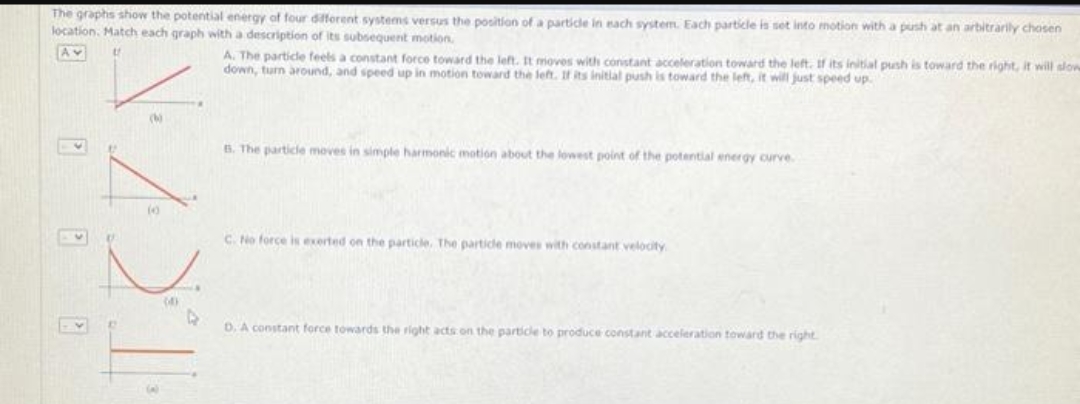The graphs show the potential energy of four different systems versus the position of a particle in each system. Each particle is set into motion with a push at an arbitrarily chosen location. Match each graph with a description of its subsequent motion. AV NZXT A. The particle feels a constant force toward the left. It moves with constant acceleration toward the left. If its initial push is toward the right, it will slow down, turn around, and speed up in motion toward the left. If its initial push is toward the left, it will just speed up. B. The particle moves in simple harmonic motion about the lowest point of the potential energy curve. C. No force is exerted on the particle. The particle moves with constant velocity D. A constant force towards the right acts on the particle to produce constant acceleration toward the right
The graphs show the potential energy of four different systems versus the position of a particle in each system. Each particle is set into motion with a push at an arbitrarily chosen location. Match each graph with a description of its subsequent motion. AV NZXT A. The particle feels a constant force toward the left. It moves with constant acceleration toward the left. If its initial push is toward the right, it will slow down, turn around, and speed up in motion toward the left. If its initial push is toward the left, it will just speed up. B. The particle moves in simple harmonic motion about the lowest point of the potential energy curve. C. No force is exerted on the particle. The particle moves with constant velocity D. A constant force towards the right acts on the particle to produce constant acceleration toward the right
Principles of Physics: A Calculus-Based Text
5th Edition
ISBN:9781133104261
Author:Raymond A. Serway, John W. Jewett
Publisher:Raymond A. Serway, John W. Jewett
Chapter6: Energy Of A System
Section: Chapter Questions
Problem 68P
Related questions
Question

Transcribed Image Text:The graphs show the potential energy of four different systems versus the position of a particle in each system. Each particle is set into motion with a push at an arbitrarily chosen
location. Match each graph with a description of its subsequent motion
AV
(6)
AXT
(0)
A. The particle feels a constant force toward the left. It moves with constant acceleration toward the left. If its initial push is toward the right, it will slow
down, turn around, and speed up in motion toward the left. If its initial push is toward the left, it will just speed up.
B. The particle moves in simple harmonic motion about the lowest point of the potential energy curve.
C. No force is exerted on the particle. The particle moves with constant velocity
D. A constant force towards the right acts on the particle to produce constant acceleration toward the right
Expert Solution
This question has been solved!
Explore an expertly crafted, step-by-step solution for a thorough understanding of key concepts.
Step by step
Solved in 4 steps with 5 images

Knowledge Booster
Learn more about
Need a deep-dive on the concept behind this application? Look no further. Learn more about this topic, physics and related others by exploring similar questions and additional content below.Recommended textbooks for you

Principles of Physics: A Calculus-Based Text
Physics
ISBN:
9781133104261
Author:
Raymond A. Serway, John W. Jewett
Publisher:
Cengage Learning

Physics for Scientists and Engineers: Foundations…
Physics
ISBN:
9781133939146
Author:
Katz, Debora M.
Publisher:
Cengage Learning

Physics for Scientists and Engineers with Modern …
Physics
ISBN:
9781337553292
Author:
Raymond A. Serway, John W. Jewett
Publisher:
Cengage Learning

Principles of Physics: A Calculus-Based Text
Physics
ISBN:
9781133104261
Author:
Raymond A. Serway, John W. Jewett
Publisher:
Cengage Learning

Physics for Scientists and Engineers: Foundations…
Physics
ISBN:
9781133939146
Author:
Katz, Debora M.
Publisher:
Cengage Learning

Physics for Scientists and Engineers with Modern …
Physics
ISBN:
9781337553292
Author:
Raymond A. Serway, John W. Jewett
Publisher:
Cengage Learning

Physics for Scientists and Engineers
Physics
ISBN:
9781337553278
Author:
Raymond A. Serway, John W. Jewett
Publisher:
Cengage Learning

University Physics Volume 1
Physics
ISBN:
9781938168277
Author:
William Moebs, Samuel J. Ling, Jeff Sanny
Publisher:
OpenStax - Rice University

College Physics
Physics
ISBN:
9781285737027
Author:
Raymond A. Serway, Chris Vuille
Publisher:
Cengage Learning